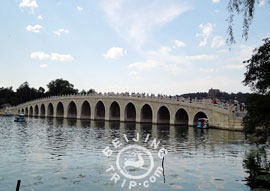 Seventeen-Arch Bridge
Seventeen-Arch Bridge
The Seventeen-Arch Bridge is the only connection to the Nanhu Island. It was built during the reign of Emperor Qianlong in the Qing Dynasty (1644-1911). No matter how you look at the great bridge, it is beautiful, like a rainbow or an ornamental ribbon. The Summer Palace does, indeed, offer many scenic spots. The Seventeen-Arch Bridge is an imitation of the celebrated Marco Polo Bridge (Lugou Bridge) in Fengtai District, Beijing.

As the name suggests, it has seventeen symmetrical arches, with the largest one in the center and the others diminishing in size on either side. The arch and its reflection in water are an awesome sight. The bridge is 150 meters (164 yards) long and 7 meters (23 feet) high, which gets corresponds with the grandeur of the imperial garden. The bridge is decorated with 544 delicately carved lions. This vivid lions, sitting on the white marble balusters, have different expressions and postures.
 Nanhu Island
Nanhu Island
The Nanhu Island with an area of over one hectare (2.5 acres) is the largest one among the three islands in the Kunming Lake. The island situated in the southeast of the lake, is connected with the east bank by the Seventeen-Arch Bridge. The whole island is edged by laid huge stones and enclosed with carved stone fence. Seen from the distance, the island together with the Seventeen-Arch Bridge looks like a tortoise stretching his neck. As tortoise is a symbol of longevity in Chinese culture, the similarity in shape justly satisfied Emperor Qianlong, who built this garden in the name of celebrating his mother's sixtieth birthday.
The main structures on the island are the Hanxu Hall and the Dragon King Temple. The pavilion-style Hanxu Hall is the shelter where Empress Dowager Cixi inspected the navy drill. The Dragon King Temple is said to have been built on the bank in the Ming Dynasty (1368-1644). Its surrounding land was deliberately retained when the lake was excavated and enlarged afterwards, thus the isolated island emerged. In ancient times, Dragon King was deemed as a mythical divine master of the rain. Every time Cixi came to the Summer Palace by waterway, she made a stop-over for the set purpose of worshiping at the temple.
 Go to the Next Attractions: Longevity Hill & Long Corridor
Go to the Next Attractions: Longevity Hill & Long Corridor